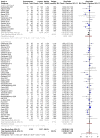Efficacy and safety of oral and sublingual versus vaginal misoprostol for induction of labour: a systematic review and meta-analysis
- PMID: 36472645
- PMCID: PMC10348969
- DOI: 10.1007/s00404-022-06867-9
Efficacy and safety of oral and sublingual versus vaginal misoprostol for induction of labour: a systematic review and meta-analysis
Abstract
Objective: Misoprostol is a synthetic PGE1 analogue that is used for induction of labour. Current guidelines support the use of doses that do not exceed 25 mcg in order to limit maternal and neonatal adverse outcomes. The present meta-analysis investigates the efficacy and safety of oral compared to vaginally inserted misoprostol in terms of induction of labor and adverse peripartum outcomes.
Methods: We searched Medline, Scopus, the Cochrane Central Register of Controlled Trials CENTRAL, Google Scholar, and Clinicaltrials.gov databases from inception till April 2022. Randomized controlled trials that assessed the efficacy of oral misoprostol (per os or sublingual) compared to vaginally inserted misoprostol. Effect sizes were calculated in R. Sensitivity analysis was performed to evaluate the possibility of small study effects, p-hacking. Meta-regression and subgroup analysis according to the dose of misoprostol was also investigated. The methodological quality of the included studies was assessed by two independent reviewers using the risk of bias 2 tool. Quality of evidence for primary outcomes was evaluated under the Grading of Recommendations Assessment, Development and Evaluation (GRADE) framework, ranging from very low to high.
Results: Overall, 57 studies were included that involved 10,975 parturient. Their risk of bias ranged between low-moderate. There were no differences among the routes of intake in terms of successful vaginal delivery within 24 h (RR 0.90, 95% CI 0.80) and cesarean section rates (RR 0.92, 95% CI 0.82, 1.04). Sublingual misoprostol was superior compared to vaginal misoprostol in reducing the interval from induction to delivery (MD - 1.11 h, 95% CI - 2.06, - 0.17). On the other hand, per os misoprostol was inferior compared to vaginal misoprostol in terms of this outcome (MD 3.45 h, 95% CI 1.85, 5.06). Maternal and neonatal morbidity was not affected by the route or dose of misoprostol.
Conclusion: The findings of our study suggest that oral misoprostol intake is equally safe to vaginal misoprostol in terms of inducing labor at term. Sublingual intake seems to outperform the per os and vaginal routes without increasing the accompanying morbidity. Increasing the dose of misoprostol does not seem to increase its efficacy.
Clinical trial registration: Open Science Framework ( https://doi.org/10.17605/OSF.IO/V9JHF ).
Keywords: Induction of labour; Maternal morbidity; Meta-analysis; Misoprostol; Neonatal morbidity; Oral; Sublingual; Systematic review.
© 2022. The Author(s).
Conflict of interest statement
The authors declare that they have no conflicts of interest to disclose.
Figures



Similar articles
-
Epidural versus non-epidural or no analgesia for pain management in labour.Cochrane Database Syst Rev. 2018 May 21;5(5):CD000331. doi: 10.1002/14651858.CD000331.pub4. Cochrane Database Syst Rev. 2018. PMID: 29781504 Free PMC article.
-
Induction of labour for improving birth outcomes for women at or beyond term.Cochrane Database Syst Rev. 2018 May 9;5(5):CD004945. doi: 10.1002/14651858.CD004945.pub4. Cochrane Database Syst Rev. 2018. Update in: Cochrane Database Syst Rev. 2020 Jul 15;7:CD004945. doi: 10.1002/14651858.CD004945.pub5. PMID: 29741208 Free PMC article. Updated.
-
Vaginal misoprostol for cervical ripening and induction of labour.Cochrane Database Syst Rev. 2003;(1):CD000941. doi: 10.1002/14651858.CD000941. Cochrane Database Syst Rev. 2003. Update in: Cochrane Database Syst Rev. 2010 Oct 06;(10):CD000941. doi: 10.1002/14651858.CD000941.pub2. PMID: 12535398 Updated.
-
Planned birth at or near term for improving health outcomes for pregnant women with gestational diabetes and their infants.Cochrane Database Syst Rev. 2018 Jan 5;1(1):CD012910. doi: 10.1002/14651858.CD012910. Cochrane Database Syst Rev. 2018. PMID: 29303230 Free PMC article.
-
Mechanical methods for induction of labour.Cochrane Database Syst Rev. 2001;(4):CD001233. doi: 10.1002/14651858.CD001233. Cochrane Database Syst Rev. 2001. Update in: Cochrane Database Syst Rev. 2012 Mar 14;(3):CD001233. doi: 10.1002/14651858.CD001233.pub2. PMID: 11687101 Updated.
Cited by
-
Efficacy and safety of misoprostol versus oxytocin for labor induction in women with prelabor rupture of membranes: a meta-analysis.BMC Pregnancy Childbirth. 2025 Apr 21;25(1):461. doi: 10.1186/s12884-025-07592-2. BMC Pregnancy Childbirth. 2025. PMID: 40259229 Free PMC article.
-
Diagnostic accuracy of pre-induction cervical elastography, volume, length, and uterocervical angle for the prediction of successful induction of labor with dinoprostone.Arch Gynecol Obstet. 2023 Oct;308(4):1301-1311. doi: 10.1007/s00404-023-07076-8. Epub 2023 May 21. Arch Gynecol Obstet. 2023. PMID: 37210702
-
Comparison of the Safety and Effectiveness of Labor Induction With 25 μg Versus 50 μg of Oral Misoprostol in Women With Premature Rupture of Membranes: A Randomized Controlled Trial.Health Sci Rep. 2025 May 5;8(5):e70817. doi: 10.1002/hsr2.70817. eCollection 2025 May. Health Sci Rep. 2025. PMID: 40330768 Free PMC article.
-
A disproportionality analysis of FDA adverse event reporting system events for misoprostol.Sci Rep. 2025 Jan 19;15(1):2452. doi: 10.1038/s41598-025-86422-z. Sci Rep. 2025. PMID: 39828758 Free PMC article.
References
-
- WHO Recommendations for Induction of Labour. Geneva: World Health Organization; 2011. 1, BACKGROUND. Available from: https://www.ncbi.nlm.nih.gov/books/NBK131965/. - PubMed
-
- Martin JA, Hamilton BE, Osterman MJK, Driscoll AK. Births: final data for 2019. Natl Vital Stat Rep. 2021;70:1–51. - PubMed
-
- European Perinatal Health Report (2010) Retrieved July 2021
-
- ACOG Practice Bulletin No 107: Induction of labor. Obstet Gynecol. 2009;114:386–397. - PubMed
Publication types
MeSH terms
Substances
LinkOut - more resources
Full Text Sources
Miscellaneous

